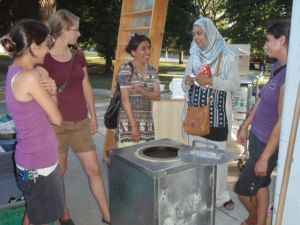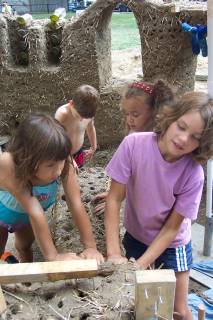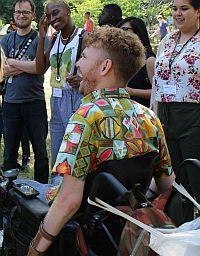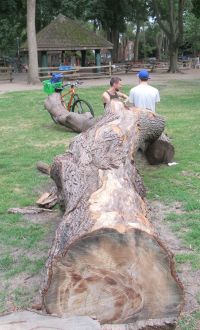Comments?
For the basics, see
- Website & Privacy Policies
- How To Get Involved
- The Role of the Park
Search options:
Department Site Map
Custodians:
Newsletter August 2018
 Jane Jacobs |
This newsletter is put out by the Centre for Local Research into Public Space (CELOS),. Since 2000, when this little organization began at Dufferin Grove Park, we’ve been doing what we call “theoretical and practical research” into what makes public spaces – like parks – more hospitable and more lively. We’ve been researching what works and what doesn’t, and we’ve documented a lot of what we’ve seen and done, in this newsletter and on our four websites.
“Vital Little Plans” for Dufferin Grove Park?
Vital Little Plans is the title of a very fine collection of Jane Jacobs' shorter writings and talks, edited by Samuel Zipp and Nate Storring and published in 2016. In one of those talks, Jacobs said “A city has to be responsible for keeping its own society endlessly involved with maintaining a city its own people can feel at home in and be proud of…..The more that cities can make of their own ordinary people’s capacities for economic and social invention and experiment, the more useful and valuable cities become – not only for their own people but also for their nations.”
Way back in May of 2002, Jane Jacobs praised the first booklet that CELOS published, Cooking with Fire in Public Parks. She said that she'd taken the time to read it from cover to cover -- because she really liked the stories of what people were doing at Dufferin Grove Park.
It was park users and on-site unionized recreation staff, who made the park work in such interesting ways, But in 2012, city management directed the staff to stop working collaboratively. Six years later, Dufferin Grove Park is in trouble.
It now costs well over a million dollars a year to run the park, park food programs that used to support other programs now cost more than they bring in, and everywhere there are signs of strain – from the weedy gardens to the dumped bathroom sink that lay in the park for a month, to unhappy staff, to a hard-to-understand plan to replace the clubhouse, the rink, and the bake ovens though all seem in pretty good shape.
But now there may be good news. A recent speech by the general manager of Parks and Recreation, Janie Romoff at the annual Park People Summit, suggests that some new possibilities are opening up. She said: “Toronto is leading the country on collaborative governance models that bring government and communities together to improve, operate and enhance parks and public realm, and each one of those partnerships and models is unique – we don’t have a one-conservancy-fits-all model, we’re actively working with each partner to create solutions that fit and that maximize our shared potential.”
Is this the time for a Dufferin Grove park conservancy?
A Dufferin Grove Park conservancy
Our guide here is Jane Jacobs. In particular, she wrote that “stagnation” in cities is caused by (among other things) “unwillingness of local government to purchase experimental and innovative goods and services (e.g. for parks…).” And Jacobs looked not so much to certified professionals but to plain citizens getting such service contracts to try things where they live – making their “vital little plans.”
We believe that with service contracts of the type Jane Jacobs proposed, it will be possible to grow an experimental approach at Dufferin Grove that can gradually become part of the Parks and Recreation culture in Toronto.
Some people call this a partnership, some a “conservancy.” Some of the “collaborative governance models” praised by the general manager may depend on philanthropy, some on professional urban planners to design a model that they believe will work. But Dufferin Grove has one unusual advantage – experience. For fifteen years, the park was already doing what is now being suggested for other parts of the city. People in this park got a lot of practical experience with what Jacobs calls vital little plans.
David Rothberg gives a $3000 donation to do the research

2011, from David Rothberg: a travelling tandoor
Long-time park friend David Rothberg helped out ten years ago to keep the local rinks open on Christmas Day and Boxing Day. He provided for a travelling tandoor oven for women who wanted to bake naan bread in Thorncliffe Park. Last February he funded the show-and-tell skate-lending days at Regent Park. Now he’s donated $3000 for research into a local version of a conservancy.
Last year the city spent about $300,000, working with the Toronto Botanical Garden staff and friends as well as landscape architects to produce an impressive “Edwards Gardens Master Plan” for a conservancy. City Council accepted the plan, and the next council, whether shrunk or the same size as now, will need to address the practicalities.
CELOS is using David Rothberg’s donation to assemble a parallel document that fits the unique situation of Dufferin Grove. While the multi-year Edwards Gardens plan depends on $50 million of fundraising, and the up-and-running Bentway Conservancy put a $25 million private donation together with a similar amount of city funds, this conservancy/partnership can’t be based on fundraising. CELOS wants to build on the 15-year experience of Dufferin Grove, to show how the existing park budget (or maybe a bit less) can be used to turn the park back into a daily collaboration between staff and park friends.
Joe Mancini on work
Joe Mancini, of The Working Centre in Kitchener, has been a long-time inspiration to Dufferin Grove Park. Referring to homeless people, he wrote to us recently: "An increasing portion of our society is excluded from work. This means they lose their place in society, losing the ability to make a contribution. Work reinforces the social bond by shaping character and culture."
Yet jobs that provide a paycheck but no more -- "MacJobs" -- are not, we think, what Joe means by work. He means good work. It's our view that good work in Dufferin Grove Park allows on-site park staff to invite park neighbours to discover, alongside the staff, what works well and what doesn't. But that’s not what’s happening at the moment.
Boring work
This summer, park users have been commenting on the sight of three (sometimes four) wading pool staff sitting on a bench by the pool often looking very bored. Well, who wouldn’t be bored by the city’s current one-size-fits all approach to staffing city wading pools? On a recent rainy morning, four summer staff were directed to fill the pool and watch it. For the first four hours of their shift, there were no children. The staff were not given any useful tasks to do. The “work” is just as bad in winter: rink guards are directed to spend their whole shift skating up and down the ice, even when there are no skaters on the ice.
And the problem gets worse. Recreation staff all over the city have been complaining about the increasing numbers of mandatory trainings they have to go to. An example is the 8-hour generic High Five training in “principles of healthy child development,” which seems to be divided between the obvious (“listen to the children”) and the credentialist (“a basketball program with trained staff is better than a program run by an untrained volunteer dad because parents can have more confidence in the program if the staff are certified”).
The fact that the city pays the staff to go to these trainings is no comfort to the young people who are the captive audience. Young staff comments run along these lines: “I spent a beautiful sunny day sitting in a basement. I didn't learn anything. A complete waste of time.”
These young staff have many capacities that could be put to use at the park, but aren’t. At Dufferin Grove, the city’s narrow and ill-fitting job descriptions are part of the cause. The wading pool and rink staff have the constraint of a single-focus task, but the park bakers and cooks and snack bar attendants have an even stranger situation: they are designated as “arts and crafts” workers, although they do neither. Management and their union – CUPE Local 79 – has never helped staff straighten this out. It seems like there’s no one paying attention at the grassroots level. But that’s not the way work at Dufferin Grove Park, or any park, has to be.
Good work: when Dufferin Grove Park was a city/community partnership
Parks can’t be run by volunteers. Everyone knows of some community group which subdivided into five or six committees with great ideas, then dwindled to a few people with far more on their task list than they had time for -- and finally the group disappeared. There were not enough park friends moti¬vated to do all that unpaid work.
And why should there be? In the case of public spaces, we have a tax-supported civil service. We pool our money to pay municipal staff to make parks work well, among other things. So from the very begin¬ning of the longtime Dufferin Grove Park/community partnership, it seemed best for park friends to work hand in hand with park staff, and to encourage good people to apply for those part-time jobs.
Now, it’s a little-known fact that park litter-pickers are paid a much higher hourly wage than the part-time recreation staff whose job is working with families and youth. But even so, over the years job applicants for recreation program jobs at Dufferin Grove kept getting better and better. The low wages were compensated by the flexibility of part-time work schedules, and by the interesting work. Thanks to the former recreation management, park staff had the freedom to try things – they were encouraged to work with park friends to find new ways to make the park more enjoyable.

2005: making friends building the cob cafe
University students, both undergraduate and graduate, began to apply, as well as actors, dancers, cooks, newcomers, yoga teachers, translators, neighbourhood mothers of young children, and even some reformed park troublemakers. The advantages of flexible hours, and the friendly and adventure¬some culture of the Dufferin Grove work crew, were an incentive for them to apply for a City part-time worker’s job despite the low wages. Some of the staff returned to working at the park for many seasons, in between their other work or study commitments.
That meant that staff turnover came to be much lower than normal for city part-time workers. With more experienced staff, used to working closely with park users, the park programs became steadily more ambitious: the sandpit, the campfires, the second bake oven, the transformation of the rink change room to park clubhouse, the farmers’ market, Friday Night supper, the various pay-what-you-can performances, the support for resident theatre company Clay and Paper and for the Cooking Fire Theatre Festival, the zamboni café and the cob café, the skateboard park, the variety of shinny hockey programs, the hundreds of school visits – all were community/parks partnerships. And the best thing was that so many new friendships were able to form in the park around all those additions.
Can a conservancy help bring this back?
Accessibility
Until 2009, the central north-south route through the park was a rutted dirt path (as the branch of the path leading off to the east still is). Yvonne, a wheelchair-bound park friend who lived half a block north on Gladstone, found that she couldn’t get into the park most days because the bumpy path rattled her wheelchair so badly that it was painful for her. So she stayed just outside, on the sidewalk, looking at the trees from a distance.
A search in the Toronto archives turned up the information that a deputation had asked the Parks Department the first time in 1925 to pave the path. But the city never found the money, until Gladstone Avenue was extended right through the park (when?). There are still people around who remember cars joyriding through the park on Gladstone, with kids jumping out of the way in both directions.
In 1973, the pavement was removed and the path reverted to dirt. There were repeated requests to pave it, more so after Yvonne started talking to staff in the 1990s. But the money never seemed to be there.

Luke Anderson stopped by
CELOS and the park staff kept trying. Then in 2009, former Ward 18 city councillor Adam Giambrone managed to get some of the funds for a wading pool renovation diverted to paving the main path. Perhaps it helped that the Accessibility for Ontarians with Disabilities Act (AODA) had been passed in 2005.
Suddenly everything got easier. Bikes could go through smoothly, strollers could be pushed along without getting the wheels stuck in mud ruts, and of course wheelchairs and walkers no longer rattled the bones of their users.
Last June, during a tour of the park by sponsored the group 8-80 Cities, Luke Anderson happened to be riding along the path in his wheelchair to meet some friends. He’s the director of the StopGap Foundation. The group being toured was a bit star-struck when he kindly – and inspiringly – stopped to explain his foundation’s approach to accessibility. CELOS has asked him to come back in August and teach us how to shape the chapter on good park access, for our conservancy proposal.
Inclusion
Park staff and CELOS also got support (from former city councillor Adam Giambrone during his second term) to get curb cuts put in at the north end of the park, and again to get a special-needs swing put into the playground. But the swing is only useful when it’s used with a special harness, so that the kids don’t slip out sideways. And that harness is never there.
There’s lots of work to be done to welcome everybody in the park – not only as park users but also as special-needs workers who can contribute to good work themselves. CELOS and a few park staff have some experience with this but we all need to learn a lot more. That’s a task near the top of the list for the conservancy.
The “Northwest Corner Revitalization Project”
In 2016, when a decision was made downtown to renovate or replace the Dufferin Grove rink house and the ovens and the nearby food gardens, the city hired LURA Consultants to do public consultations and to make a website for public information. A volunteer Community Resource Group was formed, but it only met twice, in early 2017. Then four large signs inviting public input were posted prominently in the park. But the public website has not been updated since January.
Meantime, on April 17 of this year, the city’s “Bid Award Panel” approved a contract award of $694,747 to DTAH Architects Ltd. for "professional and technical design consulting services for a new community recreation clubhouse and park improvements at northwest corner of Dufferin Grove Park." (Note: it’s possible that this contract has not yet been confirmed.)
On page 10 of the 2018 Capital Budget there is also a line item called "Dufferin Grove New Community Centre," allocating $3.14 million for 2018. This amount seems to have been pushed into 2019 now, and according to capital projects coordinator Katy Aminian, it will include replacing the rink as well. Construction is planned from January 2020 to August 2021, meaning that there will be no skating at Dufferin Rink during the 2019/2020 season, and if there are the usual delays, the 2020/2021 season may also be cancelled .
The Dufferin Rink clubhouse building and the rink are only 25 years old and both are in good shape. Tearing down concrete and replacing it with more concrete is hard to defend environmentally, since the energy needed to make concrete is the highest of any manufacturing process, with heavy reliance on coal and petroleum coke.
Are there other city parks that could make better use of those funds than Dufferin Grove?
One idea: give 75% of those funds to Thorncliffe Park for a clubhouse
For almost ten years the Thorncliffe Park Women’s Committee has been asking for a small building for their intensively-used park, including a kitchen to prepare locally-made food . But the city has always said there’s no money for a little building, or even for a park washroom. The group has now rented an adapted shipping container for a park café. But the rent is $1200 a month, and the city requires $260 a month insurance as well -- unaffordable. The group is trying to get funding from the Trillium Foundation to buy the container, but the application is a cliffhanger. Could $3 million of Dufferin Grove’s allocated $4 million (counting the landscape contractor) be used for a café-clubhouse-washroom at Thorncliffe Park instead?
Trees in the park

sociable tree trunk
The park tree inventory – a part of the conservancy proposal for Dufferin Grove – is almost done. Two giant trees, both silver maples, came down in two separate storms in late spring, but many young trees are thriving and ready to replace the missing tree canopy. The two giant tree trunks have been left lying in the park and are having a second career as very popular sitting places and play places for kids.
There was a long period in the 1990s when very little tree planting was done by the city, so most new trees from that time were planted by park friends from the neighbourhood. In 1997, the city put in some white pines and oaks (one of the pines was ceremonially planted by then-Lieutenant Governor Hilary Weston). Soon after, a Canada Trust (now TD) Friends of the Environment grant allowed more plantings, including some around the new pines and oaks, to create a more forest-like habitat. A temporary fence was put around the area, to protect the young trees from dogs. But one pine was left outside the enclosure, and it became a destination for pit bull owners, who encouraged their dogs to jump up on it – putting deep scratches into the tree trunk at the same time. Strangely, this white pine is now by far the strongest, best-looking of its kind in the park – who knows why?
In the past 15 years, city staff have planted many new trees in the park, including the two “little forests” beside Dufferin Street. Those trees are doing really well and will provide some much-needed shade for the new DOLA (dogs off leash area) planned for that part of the park. There are numerous test spots near the “little forests,” where holes were dug and then filled in, presumably by the consultant whom the city has hired to design the dog park (installation scheduled in 2019).
Dufferin Grove Organic Farmers’ Market, every Thursday 3 to 7 pm
The weekly farmers’ market news that market manager Anne Freeman sends out was titled “Trouble in paradise” for August 1. It turns out that early shoppers the week before had bought up all of Debbie Wiecha’s first small load of very fine peaches. Shoppers who got there even a few minutes after 3 were very unhappy to find no peaches. So from now on, Debbie will wait until 3 sharp to start selling. Anne wrote: “We can’t stop you from showing up at dawn to be sure you get some, but please be patient, and line up to the south if necessary.” There will be lots, though.
Editor: Jutta Mason
Illustrations: Jane LowBeer
www. dufferinpark.ca, celos.ca, cityrinks.ca, publicbakeovens.ca




 Printer friendly version
Printer friendly version

